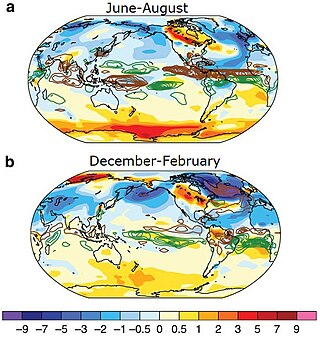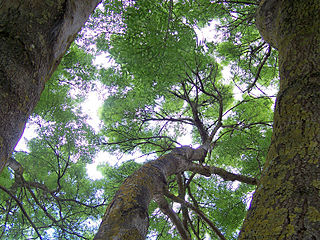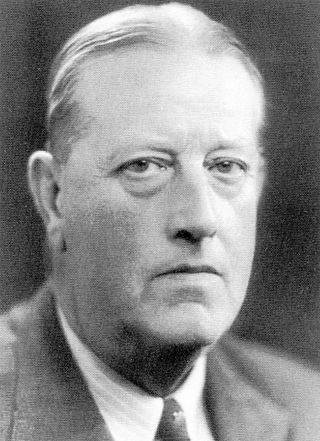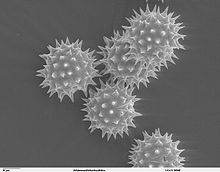
The Pleistocene is the geological epoch that lasted from c. 2.58 million to 11,700 years ago, spanning the Earth's most recent period of repeated glaciations. Before a change was finally confirmed in 2009 by the International Union of Geological Sciences, the cutoff of the Pleistocene and the preceding Pliocene was regarded as being 1.806 million years Before Present (BP). Publications from earlier years may use either definition of the period. The end of the Pleistocene corresponds with the end of the last glacial period and also with the end of the Paleolithic age used in archaeology. The name is a combination of Ancient Greek πλεῖστος (pleîstos) 'most' and καινός 'new'.

The Younger Dryas (YD) was a period in Earth's geologic history that occurred circa 12,900 to 11,700 years Before Present (BP). It is primarily known for the sudden or "abrupt" cooling in the Northern Hemisphere, when the North Atlantic Ocean cooled and annual air temperatures decreased by ~3 °C (5.4 °F) over North America, 2–6 °C (3.6–10.8 °F) in Europe and up to 10 °C (18 °F) in Greenland, in a few decades. Cooling in Greenland was particularly rapid, taking place over just 3 years or less. At the same time, the Southern Hemisphere experienced warming. This period ended as rapidly as it began, with dramatic warming over ~50 years, which transitioned the Earth from the glacial Pleistocene epoch into the current Holocene.

The Last Glacial Period (LGP), also known as the Last glacial cycle, occurred from the end of the Last Interglacial to the beginning of the Holocene, c. 115,000 – c. 11,700 years ago, and thus corresponds to most of the timespan of the Late Pleistocene.
Before Present (BP) or "years before present (YBP)" is a time scale used mainly in archaeology, geology, and other scientific disciplines to specify when events occurred relative to the origin of practical radiocarbon dating in the 1950s. Because the "present" time changes, standard practice is to use 1 January 1950 as the commencement date (epoch) of the age scale, with 1950 being labelled as the "standard year". The abbreviation "BP" has been interpreted retrospectively as "Before Physics", which refers to the time before nuclear weapons testing artificially altered the proportion of the carbon isotopes in the atmosphere, which scientists must account for.

There have been five or six major ice ages in the history of Earth over the past 3 billion years. The Late Cenozoic Ice Age began 34 million years ago, its latest phase being the Quaternary glaciation, in progress since 2.58 million years ago.

The Ahrensburg culture or Ahrensburgian was a late Upper Paleolithic nomadic hunter culture in north-central Europe during the Younger Dryas, the last spell of cold at the end of the Weichsel glaciation resulting in deforestation and the formation of a tundra with bushy arctic white birch and rowan. The most important prey was the wild reindeer. The earliest definite finds of arrow and bow date to this culture, though these weapons might have been invented earlier. The Ahrensburgian was preceded by the Hamburg and Federmesser cultures and superseded by the Maglemosian and Swiderian cultures. Ahrensburgian finds were made in southern and western Scandinavia, the North German plain and western Poland. The Ahrensburgian area also included vast stretches of land now at the bottom of the North and Baltic Sea, since during the Younger Dryas the coastline took a much more northern course than today.

An interglacial period is a geological interval of warmer global average temperature lasting thousands of years that separates consecutive glacial periods within an ice age. The current Holocene interglacial began at the end of the Pleistocene, about 11,700 years ago.
The Blytt–Sernander classification, or sequence, is a series of North European climatic periods or phases based on the study of Danish peat bogs by Axel Blytt (1876) and Rutger Sernander (1908). The classification was incorporated into a sequence of pollen zones later defined by Lennart von Post, one of the founders of palynology.
The Older Dryas was a stadial (cold) period between the Bølling and Allerød interstadials, about 14,000 years Before Present, towards the end of the Pleistocene. Its date range is not well defined, with estimates varying by 400 years, but its duration is agreed to have been around two centuries.

In paleoclimatology of the Holocene, the Boreal was the first of the Blytt–Sernander sequence of north European climatic phases that were originally based on the study of Danish peat bogs, named for Axel Blytt and Rutger Sernander, who first established the sequence. In peat bog sediments, the Boreal is also recognized by its characteristic pollen zone. It was preceded by the Younger Dryas, the last cold snap of the Pleistocene, and followed by the Atlantic, a warmer and moister period than our most recent climate. The Boreal, transitional between the two periods, varied a great deal, at times having within it climates like today's.
In the science of tephrochronology, the Saksunarvatn tephra is volcanic ejecta that formed an ash layer that is useful in dating Northern European sediment layers that were laid down during the Boreal period, the warm climate phase that followed the cold snap of the Younger Dryas as the earth made the transition from the last Pleistocene glaciation to the current interglacial, or Holocene. This was a period of rapid climatic transitions around the North Atlantic, some of which took place during a matter of decades. Similar effects are evident in independent palaeoclimatic reconstructions obtained from pollen zones, marine and ice-core records, but these sequences cannot be reliably calibrated with one another. The ash layer from a specific volcanic event, deposited simultaneously over wide areas, provides a common reference point or time marker called a horizon, which establishes simultaneity in the sequences wherever that layer is found: this set of techniques is called tephrochronology.

The Atlantic in palaeoclimatology was the warmest and moistest Blytt–Sernander period, pollen zone and chronozone of Holocene northern Europe. The climate was generally warmer than today. It was preceded by the Boreal, with a climate similar to today's, and was followed by the Subboreal, a transition to the modern. Because it was the warmest period of the Holocene, the Atlantic is often referenced more directly as the Holocene climatic optimum, or just climatic optimum.
Yoldia Sea is a name given by geologists to a variable brackish water stage in the Baltic Sea basin that prevailed after the Baltic Ice Lake was drained to sea level during the Weichselian glaciation. Dates for the Yoldia sea are obtained mainly by radiocarbon dating material from ancient sediments and shore lines and from clay-varve chronology. They tend to vary by as much as a thousand years, but a good estimate is 10,300 – 9500 radiocarbon years BC, equivalent to ca 11,700–10,700 calendar years BC. The sea ended gradually when isostatic rise of Scandinavia closed or nearly closed its effluents, altering the balance between saline and fresh water. The Yoldia Sea became Ancylus Lake. The Yoldia Sea stage had three phases of which only the middle phase had brackish water.

Ernst Jakob Lennart von Post was a Swedish naturalist and geologist. He was the first to publish quantitative analysis of pollen and is counted as one of the founders of palynology. He was a professor at Stockholm University 1929–1950.
Johann Heinrich Christfried Dau (1790–1831) was a Holstein-Danish geologist and writer, whose identification of peat layers led eventually to a system of classifying and dating post-glacial northern European paleoclimate periods, the Blytt–Sernander sequences based on peat stratigraphy.

The Subboreal is a climatic period, immediately before the present one, of the Holocene. It lasted from 3710 to 450 BCE.
The Subatlantic is the current climatic age of the Holocene epoch. It started about 2,500 years BP and is still ongoing. Its average temperatures are slightly lower than during the preceding Subboreal and Atlantic. During its course, the temperature underwent several oscillations, which had a strong influence on fauna and flora and thus indirectly on the evolution of human civilizations. With intensifying industrialisation, human society started to stress the natural climatic cycles with increased greenhouse gas emissions.

The Weichselian glaciation is the regional name for the Last Glacial Period in the northern parts of Europe. In the Alpine region it corresponds to the Würm glaciation. It was characterized by a large ice sheet that spread out from the Scandinavian Mountains and extended as far as the east coast of Schleswig-Holstein, northern Poland and Northwest Russia. This glaciation is also known as the Weichselian ice age, Vistulian glaciation, Weichsel or, less commonly, the Weichsel glaciation, Weichselian cold period (Weichsel-Kaltzeit), Weichselian glacial (Weichsel-Glazial), Weichselian Stage or, rarely, the Weichselian complex (Weichsel-Komplex).

Postglacial vegetation refers to plants that colonize the newly exposed substrate after a glacial retreat. The term "postglacial" typically refers to processes and events that occur after the departure of glacial ice or glacial climates.












